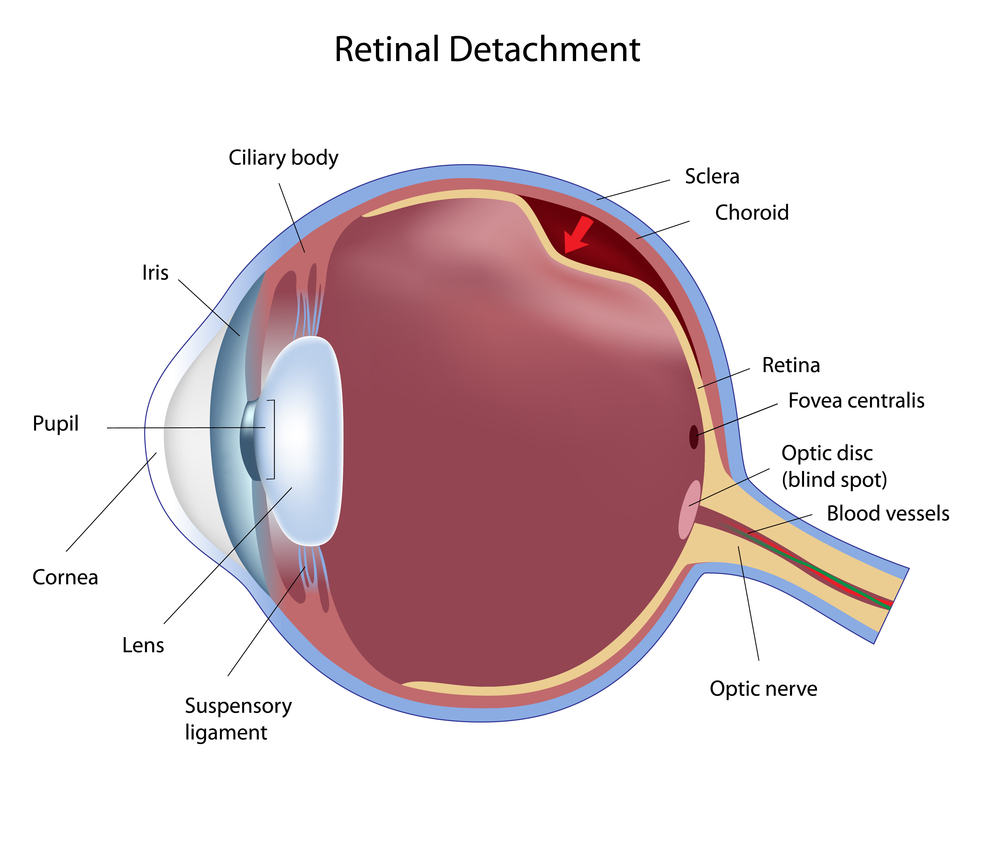What to Know About Retinal Detachment and Your Eyes
February 16, 2024
A retinal detachment is an eye condition that can seriously affect if your eyes are healthy. If not treated promptly, a retinal detachment can cause permanent vision loss.
It's essential to know your risk for retinal detachment and the signs of a retinal tear or detachment so you can get prompt treatment when those signs appear. Keep reading to learn what you need to know about retinal detachment and your eyes to keep them healthy.
What is a Retinal Detachment?
 The retina is the thin membrane that lines the back of your eye. It contains special cells that detect the light that passes through your eye.
The retina is the thin membrane that lines the back of your eye. It contains special cells that detect the light that passes through your eye.
These cells translate the light into impulses that it sends to your brain. This is how your brain gets information about what you're seeing. Without the retina, you wouldn't be able to see clearly.
A retinal detachment occurs when your retina peels away from the back of the eye. When the retina detaches from the eye, it disconnects the membrane from the blood vessels that supply it with oxygen.
Once the retinal cells become deprived of oxygen, they will die. If they die, they are unable to regenerate.
Retinal detachment requires immediate treatment to prevent vision loss. If the retina can be quickly reattached to the back of the eye, it can receive the oxygen it needs.
How Do You Know If You Have a Retinal Detachment?
 The only way to know if you have a retinal detachment is to have your ophthalmologist at Washington Eye Specialists diagnose you with one. However, there are obvious signs that you may have a retinal tear or detachment.
The only way to know if you have a retinal detachment is to have your ophthalmologist at Washington Eye Specialists diagnose you with one. However, there are obvious signs that you may have a retinal tear or detachment.
Retinal detachments primarily cause you to see a lot of floaters and flashes of light that appear suddenly. You won't feel any pain, but these floaters and flashes may also be accompanied by blurred vision, peripheral vision loss, and a shadow over your vision.
If you suddenly see an increase in floaters with flashes of light, seek emergency medical care as soon as possible. A retinal tear often precedes a retinal detachment and has milder symptoms.
You may see a few new floaters if you have a retinal tear. If you see just a few floaters and not a lot that appears very suddenly, make an appointment to see your eye doctor as soon as possible.
Although a retinal tear isn't as much of an emergency as a retinal detachment, it may lead to a retinal detachment. Diagnosing a retinal tear will help keep your eyes healthy and ensure you receive treatment as quickly as possible if you have a retinal detachment.
What Causes a Retinal Detachment?
Retinal detachments typically start with a retinal tear. A retinal tear usually occurs when the fluid that fills the eye, called the vitreous, pulls on the retina, tearing a small section.
Once there's a tear, fluid can leak through the tear under the retina and build up, pulling the retina from the back of the eye. But why does the vitreous pull on the retina?
The vitreous pulling on the retina is often a simple side effect of aging. The vitreous shrinks as you get older.
However, as the vitreous shrinks, it's more likely to get caught on the retina and tug on it. A few factors may put you at risk for a retinal tear or detachment. Being over 55 is perhaps the most significant risk factor. However, there are other risk factors, including:
- Having a previous eye injury
- Undergoing a prior eye surgery
- Having a family history of retinal detachment
- Being extremely nearsighted
- Having certain eye diseases and disorders that affect the retina
If you've had a retinal tear or detachment in the past, you're also more likely to have one again. If you know you're at risk for retinal detachment, regularly schedule eye exams with your ophthalmologist at Washington Eye Specialists and recognize the signs of a tear or detachment.
Learn More About Retinal Detachments
How is a Retinal Detachment Treated?
If you have a retinal tear that hasn't yet become a total detachment, you can often treat it to prevent detachment from occurring. Doing this is with either photocoagulation or cryopexy.
Photocoagulation uses a laser to weld the torn retina back into place, and cryopexy uses a freezing probe to do the same thing. Both these treatments are minimally invasive and performed as outpatient procedures, meaning you can go home after they are complete.
If your retina has become detached, you will need a procedure quickly, often within days of diagnosis, if not sooner. This is why you should seek emergency treatment if you have symptoms, as an emergency room physician can quickly refer you to an eye surgeon.
A retinal detachment is usually treated using one of the following procedures:
Scleral Buckling
Scleral buckling is a procedure that involves suturing a silicone material around the outside of the eye. Suturing a silicone material outside the eye puts pressure on it to counteract the tension from the vitreous pulling on the retina.
Doing this helps push the retina back into place and holds it there.
Pneumatic Retinopexy
Pneumatic retinopexy is a procedure that uses a device to create a bubble of air in the vitreous in a specific place that pushes the detached section of the retina back into place. Once complete, the tear in the retina is repaired with cryopexy.
Vitrectomy
Vitrectomy is a procedure that removes a portion of the vitreous. The removed vitreous is then replaced with either gas or silicone to push the retina back into place.
Your eye surgeon may choose to combine vitrectomy with scleral buckling, depending on the severity of the retinal detachment being repaired.
Learn more about retinal detachments by requesting an appointment at Washington Eye Specialists in Washington, DC, today!



